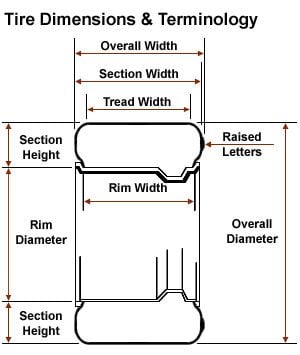Ford F-150/F-250: Tire Modifications and Size Calculator
Selecting larger tires for your Ford truck is an exciting, yet daunting task. We make it easy.
This article applies to the Ford F-150 (2004-2014) and the Ford F-250 F-350 Super Duty (2005-2014).
Selecting larger tires for your F-150 or F-250/F-350 Super Duty is an exciting, yet daunting task. The tires not only have to look like and perform the way you want them to, but they also have to fit so they don't rub or cause other fitment problems. You can go the route of paying someone to pick the tires for you, but the whole joy of customizing your truck—and adding some new shoes—is a great way to learn about what your truck can do.
Table of Contents
Understanding Tire Sizes
It's good to know how a new set of wheels will fit before buying them. Understanding how to read tire sizes is necessary when deciding to upgrade to a bigger wheel. Below, we'll explain how to determine the dimensions of your future set of wheels.

Example tire size: 225/45R17
The first three numbers in a typical size (225/45R17) are the tire's indicated section width in millimeters, measured from sidewall to sidewall. If you are familiar with measurements in inches, the section width in millimeters can be converted into inches by dividing it by 25.4. For example: 225mm / 25.4 = 8.86".
The second pair of numbers (225/45R17) is the tire's aspect ratio or profile. This percentage represents the ratio of sidewall’s section height to the tire’s section width. The section height can be calculated by multiplying the section width by the aspect ratio percentage. The answer will be the height of one sidewall.
For example:
225mm x 0.45 = 101.3mm
8.86" x 0.45 = 3.99"
The last number (225/45R17) is the diameter of the wheel or rim in inches. If you are familiar with measurements in the metric system, the wheel diameter can be converted into millimeters by multiplying it by 25.4. For example: 17" x 25.4 = 431.8mm.
To calculate the overall diameter of a tire, the sidewall height (including raised letters) must be multiplied by 2 (remembering that the tire diameter is made up of 2 sidewalls, the one above the wheel and the one below the wheel touching the ground) and add the diameter of the wheel.
101.3mm + 101.3mm + 431.8mm = 634.4mm
3.99" + 3.99" + 17" = 24.98"
Pro Tip
These calculations only reflect nominal tire dimensions, which often vary from the tire's actual physical size and/or the dimensions provided by the tire manufactures. Drivers working with close fitment tolerances or trying to maintain the original tire diameter of staggered size fitments, should use the tire manufacturer's specifications for the exact tires they are considering.
How Big Can I Go?
If you have a stock rims—and don’t want to shell out the money for new ones—but still want to add a little something to your truck, you can run 33x12-inch tires if it is a four-wheel-drive F-150 and 31x12.5-inch tires if it is a two-wheel-drive F-150.
On lifted trucks, two inches or larger, you can run 35x12.5-inch tires if it is a four-wheel-drive truck and 33x12.5-inch tires if you sport a two-wheel-drive. The same rules apply for newer trucks. The bigger the lift, the more tire you can fit under your wheel wells in terms of height. Super Duty Trucks can fit larger wheels without modification up to a point.
It is important to remember backspacing and offset when fitting new tires. Offset is the wheel’s distance from its hub-mounting surface to the centerline of the wheel, which can be one of three types and is measured in millimeters: zero, positive and negative.


- Zero offset is when the hub-mounting surface is even with the centerline of the wheel.
- Positive offset is when the hub-mounting surface is toward the front or wheel side of the wheel.
- Negative offset is where the hub-mounting surface is toward the back, or brake side, of the wheel. If wheels are not offset correctly, it could negatively affect the handling of the vehicle.
- Backspacing is similar to offset, though it is the distance from the hub-mounting surface to the inside lip of the wheel.
Pro Tip
Unsure about whether a tire will fit or not? Use the Ford-Truck's offset calculator to figure out how much space you'll have if you were to upgrade. It's not an exact tool, and it only works if your truck is stock, but it's quicker than doing all the math yourself. If your truck is already modified or if you're planning on running tight tolerances, it's a good idea to do the measurements by hand before buying a set of wheels.
Go here for the Ford-Trucks.com Wheel and Tire Width Offset Calculator
Making Your Wheels Fit
Sometimes you want a tire that just won’t fit. Don’t worry, there are ways to make it work. Wheel spacers are a great option. These go between the wheel and the hub to push the tire further outside the car. This can help eliminate any unnecessary rubbing that may occur. However, wheel spacers can also change the suspension geometry and cause stress on the system.

Fender rolling is another option that can help reduce rubbing. This is the action of taking the lip of the fender, which is a “L” shape and making it into a “V.” This incremental change can be enough to make a larger tire fit properly. There is a danger of paint cracking, so be careful.

Life After a Big Wheel Upgrade
Upgrading to larger wheels and tires is a big change for your truck's other components. They will throw off the readings on your speedometer and odometer, for example, which were calibrated for factory-sized tires. To correct this, you can have your speedometer recalibrated. Or, if you don't want to bother, you can do the mental math to figure out how fast or how many miles you are really traveling.
If you already know the number of revolutions per mile on your old and new tires, it's just a matter of subtracting one number from the other to calculate the difference in speed. If you don't know this off-hand and you've already installed your big tires, no problem. Just take a drive down a stretch of highway at 60 MPH and calculate how long it takes you to drive from one mile marker to the next. One mile at 60 MPH takes 60 seconds. If you get there in 54 seconds, it’s because your tires travelled 10% more than your car thinks (assuming it could think). This disparity has two important effects:
- Your actual speed is 10% higher than what your speedometer is reflecting. When your speedometer reads 60, you are actually traveling 66. Basic math tells us that in this scenario, 10=11, 40=44, 100=110, and so on. So, when you see a speed trap ahead, remember to slow down accordingly.
- Your actual mileage is 10% more than what your odometer is reading. When your odometer reads 100 miles, you have actually traveled 110.
Which brings us to one final point. When you sell your car, don't forget to disclose that you have larger tires and remember to pay this valuable information forward so they, too, can avoid the dreaded speed trap.
Related Discussions
- Wheel and Tire Fitment Guide - 2009 and Newer - F150forum.com
- Wheel and Tire Fitment Guide 2004-2008 - F150forum.com
- Wheel Spacer Discussion - F150forum.com
- Sidewall Height Discussion - F150forum.com
- Tire Fitment Shortcut - F150forum.com
- Speedometer Calibration - F150forum.com
- Calculating Proper Tire Dimensions - Tirerack.com






